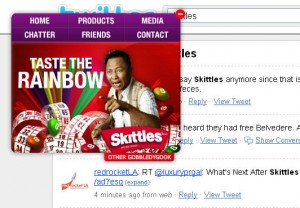From Viral Marketing to Authenticity Marketing

I've seen the word "Skittles" in the tweets of people I follow on the micro-blogging platform Twitter for a few days. If you are also on this one, you must have heard about it. I didn't quite understand the Twittersphere 's craze for this product name until I did a little research yesterday morning. Thanks to this one, I learned that the Skittles site was coming out of a redesign. Thus, it now displays a site in two layers: the first consisting of the main menu specific to Skittles and the second of a site with user-generated content. Thus, you have access, through the menu, to the "Skittles" channel in Youtube , to photos tagged with the name of the brand in Flickr , to their Facebook group and to the results page for the keyword "Skittles" of the Twitter search engine. The home page was first that of the search results in Twitter, then changed to that of the Facebook group and just changed again today to display the Skittles Wikipedia page!
A viral marketing campaign based on user-generated content sites
Some spoke of demographic targeting error on the part of the Skittles marketing team since the consumers of this candy from the Mars company are mainly appreciated by teenagers and pre-teens. Changing the homepage from Twitter Search to Facebook Group would therefore be the action indicating their awareness of this mistake, as MySpace and Facebook sites are much more used by teenagers than Twitter. I had the same opinion until I realized they changed again today to the Wikipedia page. So I conclude that they only cared about the media buzz using the most well known and talked about social sites (or that they have a good crisis management team). So it was another viral marketing campaign that used, this time,
In the case of this campaign as well as that of Weallhatequickbooks , it is no longer the brand that talks about it, but it is the opinions, discussions and thoughts of users that appear with it. The current problem, no doubt due to the novelty effect, is that users, when they learn of the existence of these campaigns, have fun tweeting all sorts of things, with more or less convenience, to see each other and make noise on the site.

Towards authenticity
However, with the increase in the use of technology such as Twitter, access to data through APIs and with the development of third-party tools and services for these technologies, we could gradually enter authenticity marketing where the opinion of users, the discussions between them and between users and employees of the company could be displayed directly on the web pages of the companies and brands. It would therefore be a bit like sharing on your site "everything" that is said in your telephone support, in your e-mail exchanges with a customer and in the telephone calls of your salespeople, as well as everything that is said about your company between people.
Some companies might be scared off by this step towards authenticity, because it's like we're asking them to bare themselves. However, with the appearance of Facebook, a turning point has been taken by Internet users: they now display their real name, their jobs, and everything that was, until recently, a matter of private and personal life. . They therefore consider it more and more normal that companies are authentic and that they are not afraid to admit their strength and their weakness.
How to take the step towards authenticity?
At least three possibilities exist to adapt your marketing strategy to a desire for authenticity:
The first is to pay or sponsor important actors (or influencers) on the Web to positively highlight the company or the brand as more and more companies are doing . However, you have to be careful and leave a great deal of freedom to the sponsored as well as display this sponsorship because, failing this, you risk having a blowback on your notoriety when users notice what they will consider as a scam or deception.
The second is to better understand and meet the needs of the user, respecting their abilities and intentions in order to increase their user experience. You also need to know which market niches your products are in, who they are aimed at, which users will have an enhanced experience with your products, and all of this, without hiding your face otherwise you will not be addressing to the right users. It is thanks to this data that you will be able to be authentic with Internet users and that they will return the favor to you.
It goes without saying that these two possibilities can be implemented together and these could then even increase your visibility in a particular media channel for particular users who will find your particular company since it corresponds exactly to who they are and what that they need. You will then be able to establish and benefit from the community effect created around your company.
Authenticity Marketing
Ultimately, authenticity marketing means letting its users have some of the power that the company has over its visibility. Thus, by outsourcing part of the company's visibility work, this makes it possible to reduce the user's feeling of aggression, due to the ever-increasing numbers of intrusive advertisements, while refocusing marketing on the role it has to play in user satisfaction and the company's business objectives.
-2.png)






